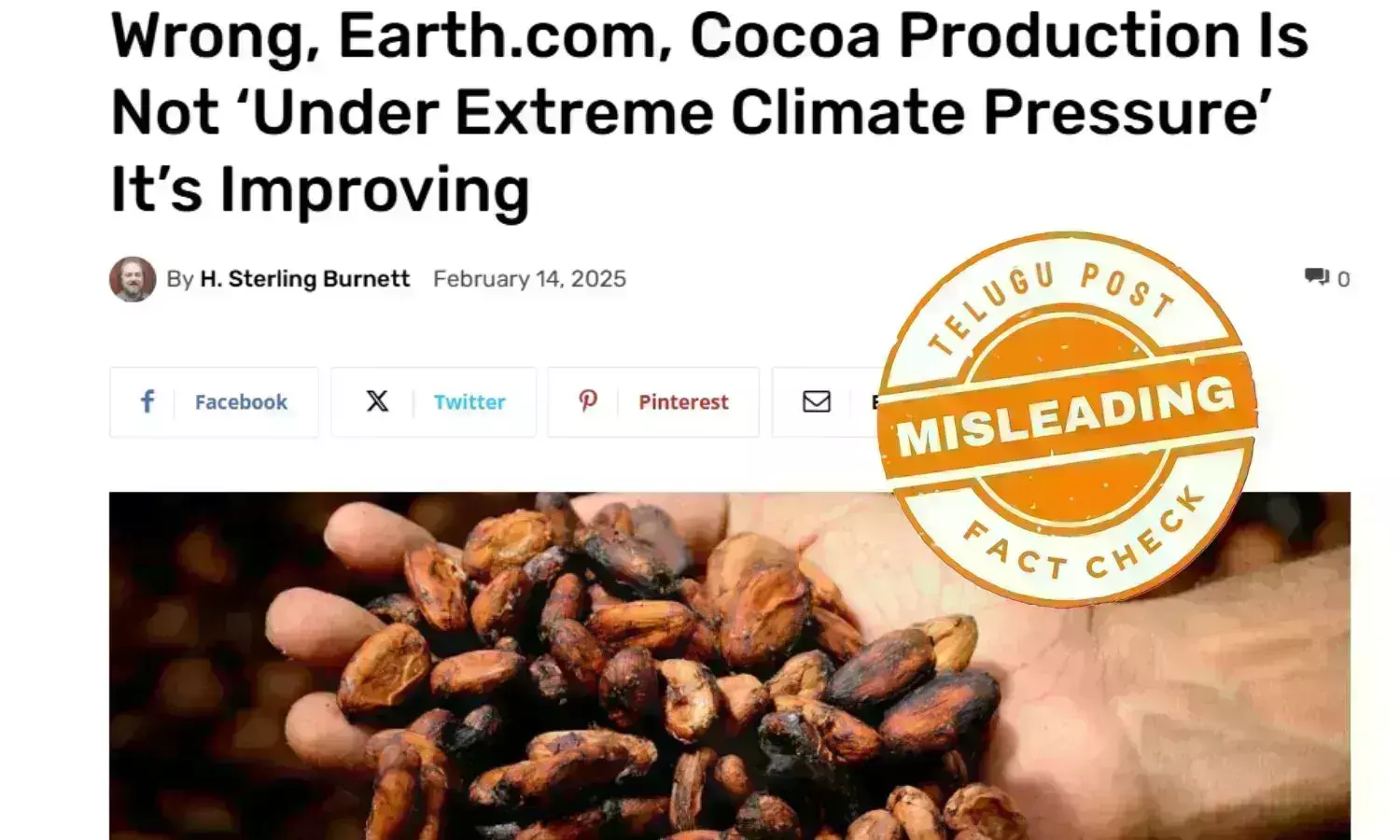Fact Check: Cocoa production has decreased due to climate change, article in Climate Realism is misleading
Cocoa is a key ingredient in chocolate. It comes from the seeds of the cacao tree, which are roasted, ground, and then

Claim :
Cocoa production in West and Central Africa is increasing, there is no impact of climate changeFact :
Deforestation and climate changes, including unpredictable rainfall patterns and droughts, are decreasing cocoa production
Cocoa is a key ingredient in chocolate. It comes from the seeds of the cacao tree, which are roasted, ground, and then processed into either cocoa powder or cocoa liquor. Cocoa production is concentrated in West Africa, with Cote d’Ivoire and Ghana being the largest producers, together accounting for over 50% of the world’s supply. In 2021, Côte d'Ivoire alone produced approximately 2.1 million metric tonne of cocoa beans, according to Statista. Globally, cocoa production reached over 5 million tonne per year as of 2023, with a value of $16 billion.
An article published on a website named Climate Realism claims data shows that cocoa production has increased during the last few decades of modest warming, rather than falling. Part of the reason for this is improved growing conditions in those regions and carbon dioxide fertilization.
The article goes on to claim that the research in particular focuses on cocoa production in Cameroon, the Ivory Coast (Côte d’Ivoire), Ghana, and Nigeria. FAO data for those countries show that since 1990:
- In Cameroon, cocoa bean production has grown by more than 157 percent;
- In the Ivory Coast (Côte d’Ivoire), cocoa bean production increased by more than 194 percent (nearly doubling and setting a new record in 2023);
- In Ghana, cocoa bean production expanded by just over 122 percent;
- In Nigeria, cocoa bean production grew by almost 17 percent.
With these facts in mind, there is no evidence whatsoever that climate change is putting cocoa production under extreme pressure, except perhaps in the imagination of Earth.com’s Ionescu.
Globally, carbon dioxide has resulted in a general greening of the Earth with significantly improved crop production. There is good reason to believe that rising carbon dioxide concentrations has significantly contributed to West and Central Africa’s improved cocoa production, as well. There is no good reason found in botany, agronomy, or climatology – outside of climate model projections– for thinking growing conditions in the region will change for the worse.
Here is the screenshot of the article.
Fact check:
The claim is Misleading. Experts confirm that the climate change is decreasing the cocoa production in West and Central Africa.
An article published in Down to Earth states that a new study suggests that ongoing climate change is affecting cocoa production in West and Central Africa. The area is responsible for over 70 percent of the world's cocoa production. The study was conducted in the four main cocoa producing countries — Ivory Coast, Ghana, Nigeria (west Africa), and Cameroon (central Africa). Ivory Coast and Ghana are the largest producers, followed by Nigeria and Cameroon. The research replicated both the mean and variability in yield over a 30-year period in the past (1980–2010) and in the future (2030–2060). The report was published in the journal Agricultural and Forest Meteorology. The researchers simulated potential water-limited cocoa yields to evaluate ethe ffects of warming and precipitation changes based on five plausible general circulation models climate-change scenarios, with and without elevated CO2.
The findings indicated that temperature and rainfall changes are rendering some regions less ideal for cocoa farming, whereas other areas might gain advantages from the changing climate. The effects are expected to differ by region, with changes in the climate suitability of production areas and a possible reduction of 50 per cent in the currently suitable climatic area by 2050. The study's findings indicated that with future climate changes, cocoa production (suitable growing regions) might move more from Ghana and Ivory Coast, which currently account for over 60 percent of the world's cocoa production, towards eastern countries such as Nigeria and Cameroon.
This change in production could greatly impact countries such as Cameroon, as potential rises in cocoa production in this new region could severely affect forest areas. Cameroon is among the African nations where a significant portion of rainforests and related biodiversity remains intact. Managing the adaptation of cocoa production to climate change while avoiding deforestation caused by cocoa expansion will be a major challenge both now and in the future.
Climate change significantly impacts cocoa production, primarily through altered rainfall patterns and increased temperatures, leading to reduced yields, decreased quality, and increased vulnerability to pests and diseases. These effects, particularly in major cocoa-producing regions like West and Central Africa, are projected to shrink the area suitable for cocoa cultivation and potentially make it unsustainable in some areas. Here is the link to the study published on Science direct.
In a report published in International Water Management Institute, changing climate patterns are partially responsible for the drop in cocoa production. In Ghana and Côte d’Ivoire which account for 60% of the world’s cocoa production, unusually high temperatures and rainfall caused by the El Nino phenomenon devastated crops last year. This year it has brought severe drought to the region reducing the cocoa yield even further.
The decline, however, is not something that happened overnight but is the result of long-term factors whose effects are only now reaching crisis levels. Shifts in land use dynamics as cocoa competes with urbanization and expanding agricultural frontiers, crop disease in the form of swollen stems, and galamsey, the widespread practice of illegal gold mining which leaves land contaminated by heavy metals and illegal logging, have all contributed to the dwindling production. A study by the International Water Management Institute (IWMI) shows that there has been a significant decline in precipitation over the past thirty years, with increased water stress and a drier climate.
A new analysis by scientists at research nonprofit organization, Climate Central, highlights how climate change has pushed temperatures above the optimal range for cacao trees in Western Africa. West African countries have long been the heart of cocoa production, producing around 3.48 million metric tons of cocoa beans in the 2022-2023 season. This massive output is vital to the global chocolate industry, where it takes about 400 cocoa beans to make just one pound of chocolate. Millions of farmers depend on the crop for their livelihood. In Ghana, cocoa production provides employment for 3.2 million farmers and workers, more than 10% of its total population. "Climate change is threatening the existence of cocoa farmers and their sources of livelihood," says cocoa farmer Emmanuel Essah-Mensah from Ghana, who advises several hundred cocoa farmers.
AFP also debunked this claim and proved that it is misleading.
Hence, the claim published in the article on Climate realism is Misleading. There is substantial evidence that climate change is decreasing the cocoa production in Africa.

